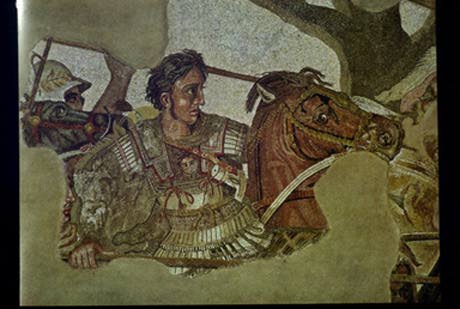
Companion Cavalry
The cavalry Companions were heavily armored horsemen who were armed with a spear and sword. In Alexanders campaignes there were 200-300 units of these horsemen and their were a handful of Royal Companions that were called agema. These units were a key factor in this war especially because they were a swift way of getting place to place, and also quick in battle despite the fact the men riding were armored.
Hypaspists
The Hypaspists were very effective in Alexanders battles because of their wide range of tactics. They could almost complete any task even though they were infantry. They acted as an aid to the phalanx by protecting the right flank and they were also good for skirmishing, and storming walls. They were even quick enough to aid the cavalry.
Phalanx/Hoplites
The Greek hoplites are very different from the Macedonian hoplites. The Greek hoplites has an enourmous shield which was quite heavy only enabling them to carry a small pike or spear because the weight in both arms would be too much to bear. Knowing this King Philip made the shields of the hoplites smaller and now instead of being held the shields were slung over their left shoulders enableing them to carry a spear anywhere from 13-17 ft in both hands. Another adjustment Philip made was that he lengthened the phalanx to 16 rows of men instead of the Greek phalanx which had 8. The first five rows of men in the Macedoinian phalnx had their sarisa or spears pointing forward. The rest of the rows had their sarisa pointing to the sky. This provided a good defense against the enemy missiles.
Auxilary Troops
Alexander did not only bring his own men on his campaigns but he also employed many auxilary, or allied troops, and brought them too. Probably the most effective auxilary troops were the Thessalians, these people had the best horses and they were the best horsemen. The elite group of the Thessalian horsemen were called the Pharsalus Squadron, these men were the people who protected the ruler of Thessaly.
Macedonian Seigecraft
The oxybeles was the most common form of seige craft that the King Philip had established. They had a missile engine that would hurl darts or large bolts at the enemy forces, ranging up to a quarter mile. Alexander's battle with the Scythians was the first place in his campaighns where the use of artillery was used. His train included siege ladders, battering-rams and siege towers, and many of his engines were built on the spot. Alexander's chief engineer was Diades, and as u can see he must have been a large part in getting to Alexanders goal.
Some probable army sizes
Macedonian invasion force of 334 BC - 36,000
Macedonians at
Issus - 30,000
Macedonians at
Gaugamela - 47,000
Macedonians at
the Hydaspes - 41,000
Persians at the
Granicus - 25,000
Persians at Issus
- 100,000
Persians at Gaugamela
- 90,000
Indians at the
Hydaspes - 30,000
agema - élite units of the hetairoi and hypaspists
argyraspids -
Silver Shields; Macedonian veteran crack infantry; 3,000 strong
hetairoi - Macedonian
Companion cavalry; heavily armored nobilty horsemen
hipparchy - four
ilai of hetairoi
hoplite - heavily
armored Greek footman
hoplon - large round
shield of the Greek hoplites; wooden core covered with bronze
hypaspists -
Macedonian crack infantry; 3,000 strong
ile (plural: ilai)
- squadron of hetairoi; 200-300 horsemen
javelin - 4 feet
or 5 feet long spear; missile weapon
pelta - wicker
shield of the peltasts
peltast - lightly-armed
infantry man armed with a bundle of javelins and a wicker shield; Thracian
origin
pezhetairoi -
Foot Companions of the Macedonian phalanx; infantry carrying the sarisa and
a light shield
phalanx - Greece:
battle line formation of hoplites, usually 4 to 8 deep; Macedonia: battle
line formation of pezhetairoi, usually 16 deep and divided in
taxis
prodromoi - Thracian
light cavalry; mounted scouts armed with a sarisa
sarisa - 13 feet to
17 feet pike used by the Macedonian pezhetairoi (phalanx)
sarisophori -
prodromoi
taxis - Macedonian
phalanx battalion of 1,526 pezhetairoi
xyston - short
thrusting spear or lance of the hetairoi and Thessalian cavalry
Battles (Major)
Battle of Granicus - 334 B.C.Battle of Issus - 333 B.C.
Battle of Gaugamela - 331 B.C.
Battle of Hydaspes - 326 B.C.